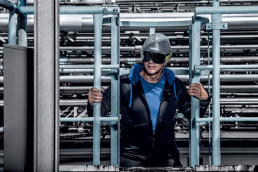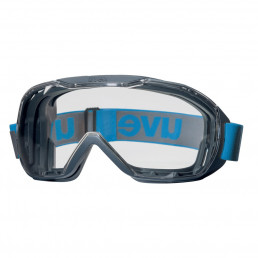Amidst the current COVID-19 pandemic, we’re often asked which safety spectacles are the best to combat disease and protect against direct contact with viruses. In this article, we’d like to answer those questions. We’d also like to provide some information on how to clean and disinfect your safety spectacles when using them for this purpose.
Are uvex safety spectacles suitable for infection control?
uvex safety spectacles are not medical products or anti-virus safety spectacles. They are a type of personal protective equipment for protecting eyes against mechanical, optical and chemical risks in accordance with EN166. We therefore cannot guarantee that they provide protection against infection or limit the spread of the COVID-19 virus. However, wearing eye protection can at least help to reduce your chance of infection.
According to current medical studies, the COVID-19 virus—better known as the coronavirus — is mainly transmitted by droplets, meaning you can become infected if droplets containing the virus reach areas such as the mucous membranes of your nose, mouth or eyes. It’s also possible to transmit the virus with your hands by smear infection, which means that if you have droplets containing the virus on your hands and then touch your mouth or eyes, this can lead to infection.

To prevent this, international health authorities such as the Robert Koch Institute (RKI), the European Centre for Disease Prevention and Control (ECDC), the World Health Organization (WHO) and the US Centers for Disease Control and Prevention (US CDC) recommend wearing goggles with indirect ventilation to protect against splashing liquids and droplets at the same time. These safety spectacles should have frame marking 3 in accordance with EN 166. Unlike goggles, standard safety spectacles do not offer this type of protection. You should also ensure that the goggles fit correctly — they should fit snugly around your entire face, especially at the sides and around your nose. Please also note that your employer is responsible for providing appropriate protective equipment.
The following models have the frame marking 3 (protection against liquids, splashes and droplets) in accordance with EN 166:

Recommendations for cleaning and disinfecting uvex safety spectacles after coming into contact with COVID-19
Cleaning and looking after your safety spectacles is always very important — however, given the current situation and risk of infection from the coronavirus, extra care should be taken when cleaning your spectacles. You should clean your safety spectacles at least after each wear — preferably also in between. You can do this by washing your spectacles with soap and running water, and an additional disinfectant can also be used.
Please observe the following steps when cleaning and disinfecting:
- Read the instructions provided with your safety spectacles.
- Wear disposable nitrile or latex safety gloves while cleaning.
- Rinse the uvex safety spectacles under running water.
- After cleaning, an additional disinfectant spray or wipe can be used — if you choose to do this, read and observe the instructions for your chosen disinfectant with regards to its compatibility, usability, disinfection procedure and exposure time. The spectacles usually require another thorough rise with clean water after being cleaned with a disinfectant. Do not submerge the spectacles in disinfectant, as this can lead to premature damage.
- Allow the glasses to air dry in a non-contaminated area.
Check the safety spectacles for damage before use. Frequent use of strong disinfectants can damage the lens coating and other parts of the glasses. uvex has not tested which disinfectants are best suited to each uvex product. Unsure which disinfectants are effective against viruses? You can check with the Robert Koch Institute or the European Centre for Disease Prevention and Control (ECDC)
If you have any further questions, please don’t hesitate to get in touch!